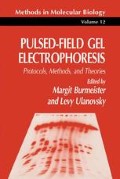Abstract
Pulsed-field gel electrophoresis (PFGE) has the capacity to fractionate large fragments of DNA up to thousands of kilobases in size. This aspect of the technique has been exploited for constructing long-range restriction maps of chromosomes from many different species including humans (see Chapters 14, 15, and 18). Besides its use for analytical purposes, PFGE has also been used as a preparative tool. Intact DNA obtained from preparative PFGE gels has been used for cloning into yeast artificial chromosome (MC) vectors (see Chapter 16) and for constructing jumping libraries (1). In addition, DNAeluted from PFGE gels has been used for generating libraries with a smaller insert size (2–7). In this latter procedure, DNA from a somatic cell hybrid is digested with a rare-cutting restriction enzyme, separated by PFGE, and the DNA from a particular PFGE fragment is eluted, digested, and cloned into a plasmid or phage vector. The resulting library is then screened with a species-specific probe to identify DNA segments from the donor chromosome of the hybrid. This use of preparative PFGE has had widespread application in the cloning of DNA close to several important disease genes, namely cystic fibrosis (4,6), Duchenne muscular dystrophy (2), choroideremia (7), polycystic kidney disease (3), and Huntington disease (5)
Access this chapter
Tax calculation will be finalised at checkout
Purchases are for personal use only
References
Collins, F. S., Drumm, M. L., Cole, J. L., Lockwood, W. K., Vande Woude, G. F., and Iannuzzi, M. C. (1987) Construction of a general human chromosome Jumping library, with application to cystic fibrosis. Science 235, 1046–1049.
Anand, R., Honeycombe, J., Whittaker, P. A., Elder, J. K., and Southern, E. M. (1988) Clones from an 840-kb fragment containing the 5′ region of the DMD locus enriched by pulsed field gel electrophoresis. Genomics 3, 177–186.
Harris, P. C., Barton, N. J., Higgs, D. R., Reeders, S. T., and Wilkie, A. 0. (1990) A long-range restriction map between the alpha-globin complex and a marker closely linked to the polycystic kidney disease 1 (PKDl) locus. Genomics 7, 195–206.
Michiels, F., Burmeister, M., and Lehrach, H. (1987) Derivation of clones close to met by preparative field inversion gel electrophoresis. Science 236, 1305–1308.
Pritchard, C., Casher, D., Bull, L., Cox, D. R., and Myers, R. M. (1990) A cloned DNA segment from the telomeric region of human chromosome 4p is not detectably rearranged in Huntington disease patients. Proc. Natl. Acad. Sci. USA 87, 7309–7313.
Ramsay, M., Wainwright, B. J., Farrall, M., Estivill, X., Sutherland, H., Ho, M. F., Davies, R., Halford, S., Tata, F., Wicking, C., Lench, N., Bauer, I., Ferec, C., Farndon, P., Kruyer, H., Stanier, P. Williamson, R. and Scambler, P. J. (1990) A new polymorphic locus, D7S411, isolated by cloning from preparative pulse-field gels is close to the mutation causing cystic fibroSIS. Genomics 6, 39–47.
van de Pol, T. J., Cremers, F. P., Brohet, R. M., Wieringa, B., and Ropers, H. H. (1990) Derivation of clones from the choroideremia locus by preparative field inversion gel electrophoresis. Nucleic Acids Res. 18, 725–731.
Marchuk, D., Cole, J., Cantor, C., Weissman, S., and Collins, F. (1988) Coincidence cloning: A method for selective cloning of sequences shared between DNA samples. Am.J, Hum. Genet. 43S, Al94 (Abstract).
Frischauf, A. M., Murray, N., and Lehrach, H. (1987) Lambda phage vectors-EMBL series. Methods Enzymol. 153, 103–115.
Nelson, D. L., Ledbetter, S. A., Corbo, L., Victoria, M. F., Ramirez, S. R., Webster, T. D., Ledbetter, D. H., and Caskey, C. T. (1989) Alu polymerase chain reaction: A method for rapid isolation of human-specific sequences from complex DNA sources.Proc. Natl. Acad Sci.. USA 86, 6686–6690.
Author information
Authors and Affiliations
Editor information
Editors and Affiliations
Rights and permissions
Copyright information
© 1992 The Humana Press Inc.
About this protocol
Cite this protocol
Pritchard, C., Burmeister, M. (1992). Construction of Lambda Libraries from Large PFGE Fragments. In: Burmeister, M., Ulanovsky, L. (eds) Pulsed-Field Gel Electrophoresis. Methods in Molecular Biology™, vol 12. Humana Press. https://doi.org/10.1385/0-89603-229-9:319
Download citation
DOI: https://doi.org/10.1385/0-89603-229-9:319
Publisher Name: Humana Press
Print ISBN: 978-0-89603-229-3
Online ISBN: 978-1-59259-499-3
eBook Packages: Springer Protocols

